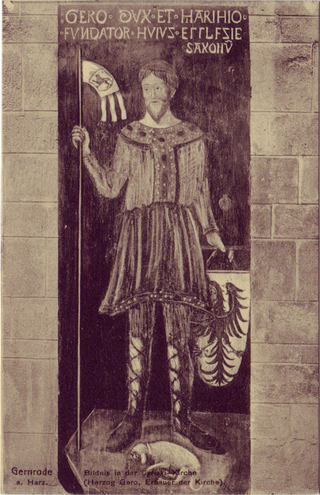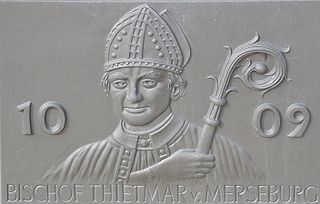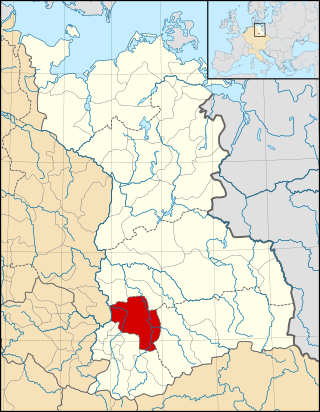Sources
- Leyser, Karl. "Henry I and the Beginnings of the Saxon Empire." The English Historical Review, Vol. 83, No. 326. (Jan., 1968), pp. 1–32.
Thietmar (I) (also Thiatmar, Dietmar, or Thiommar) (died 1 June 932), Count and Margrave, was the military tutor (vir disciplinae militaris peritissmus) of Henry the Fowler while he was the heir and then duke of the Duchy of Saxony. He probably kept a small body of elite retainers (though he once feigned at having thirty legions behind him) armed with the latest in military technology and well-supplied with expensive horses. His armored cavalry played a decisive role in winning the Battle of Lenzen on 4 September 929, securing German domination along the Elbe river against West Slavic peoples.
He married Hildegard, the maternal aunt of Hatheburg of Merseburg, first wife of Henry the Fowler. Thietmar's wife left him two sons, Siegfried, Count of Merseburg, and Gero the Great. His daughter, Hidda, married Christian of Thuringia and was the mother of Thietmar, Margrave of Meissen, Archbishop Gero of Cologne and Odo I, Margrave of the Saxon Ostmark.

The Northern March or North March was created out of the division of the vast Marca Geronis in 965. It initially comprised the northern third of the Marca and was part of the territorial organisation of areas conquered from the Wends. A Lutician rebellion in 983 reversed German control over the region until the establishment of the March of Brandenburg by Albert the Bear in the 12th century.

Gero I, sometimes called the Great, was a German nobleman who ruled an initially modest march centred on Merseburg in the south of the present German state of Saxony-Anhalt, which he expanded into a vast territory named after him: the marca Geronis. During the mid-10th century, he was the leader of the Saxon Ostsiedlung.

Thietmar, Prince-Bishop of Merseburg from 1009 until his death in 1018, was an important chronicler recording the reigns of German kings and Holy Roman Emperors of the Ottonian (Saxon) dynasty. Two of Thietmar's great-grandfathers, both referred to as Liuthar, were the Saxon nobles Lothar II, Count of Stade, and Lothar I, Count of Walbeck. They were both killed fighting the Slavs at the Battle of Lenzen.

Hermann Billung was the margrave of the Billung March from 936 until his death. The first of the Saxon House of Billung, Hermann was a trusted lieutenant of Emperor Otto I.

The Saxon Eastern March was a march of the Holy Roman Empire from the 10th until the 12th century. The term "eastern march" stems from the Latin term marchia Orientalis and originally could refer to either a march created on the eastern frontier of the East Frankish duchy of Saxony or another on the eastern border of the Duchy of Bavaria: the Bavarian marchia Orientalis, corresponding to later Austria.

The March of Merseburg was a short-lived march of the Holy Roman Empire. It comprised the lands of the Polabian Slavs beyond the margravial residence at Merseburg on the Saale river.

Eckard I was Margrave of Meissen from 985 until his death. He was the first margrave of the Ekkehardinger family that ruled over Meissen until the extinction of the line in 1046.
Dietrichof Haldensleben was a count in the Schwabengau, later also in the Nordthüringgau and the Derlingau, who was the first Margrave of the Northern March from 965 until the Great Slav Rising of 983. He also bore the title of a dux (duke) in contemporary sources.He was a ancestor of John V

OdoI was margrave in the Saxon Eastern March of the Holy Roman Empire from 965 until his death.

Herman I was Margrave of Meissen from 1009 until his death.
Gunther was the Margrave of Merseburg from 965 until his death, upon which the march of Merseburg was united to that of Meissen.

Thietmar (II) (c. 945 – 3 August 979) was Margrave of Meissen from about 976 until his death.

The Nordthüringgau was a medieval county in the Eastphalian region of the German stem duchy of Saxony.

The Schwabengau was an early medieval shire (Gau) in the Eastphalia region of the medieval Duchy of Saxony. Ruled by the House of Ascania, it became the nucleus of the later Principality of Anhalt, today part of the German state of Saxony-Anhalt.

The German–Polish War consisted of a series of struggles in 1003–1018, between the Ottonian king Henry II of Germany and the Polish Piast ruler Bolesław I the Brave. The locus of conflict was the control of Lusatia, Upper Lusatia, as well as Bohemia, Moravia and Slovakia. The fighting ended with the Peace of Bautzen in 1018, which left Lusatia and Upper Lusatia as a fief of Poland, and Bohemia became a duchy in the Holy Roman Empire.

The Battle of Lenzen was a land battle between a Saxon army of the Kingdom of Germany and the armies of the Slavic Redarii and Linonen peoples, that took place on 4 September 929 near the fortified Linonen stronghold of Lenzen in Brandenburg, Germany. The Saxon army, commanded by Saxon magnate Bernhard, destroyed a Slavic Redarii army. It marked the failure of Slavic attempts to resist German king Henry the Fowler's expansionism to the Elbe.
Henry I the Bald was Count of Stade. He was son of Lothar II, Count of Stade, and Swanhild of Saxony. Henry is recorded as a cousin of Otto I, Holy Roman Emperor, but their exact relationship remains a mystery. Henry was also appointed Count of Heilangau, the ancient capital of Stade, in 959.
Siegfried II, Count of Stade, was the youngest son of Henry I the Bald, Count of Stade, and his wife Judith von der Wetterau, granddaughter of Gebhard, Duke of Lorraine. He succeeded his brother, Henry as Count of Slade in 1016.
Siegfried I the Elder, Count of Walbeck and Möckerngau, son of Lothar II the Old, Count of Walbeck, and Mathilde von Arneburg.
Gero was a Count of Alsleben, conjectured to be the son of Siegfried and therefore grandson of Gero the Great. If so, his mother was Hedwig, daughter of Wichmann the Elder. Gero was the brother of Tetta, who established a monastery at Alsleben in his name. Thietmar of Merseburg, whose Chronicon is the major source of information here, refers to Gero as a Count in Northern Thuringia and Morzani. Gero was married to Adela of an unknown family. Gero and Adela had one daughter, Adela of Alsleben, who married Siegfried II, Count of Stade. No other counts of Alsleben are recorded until the 12th century.